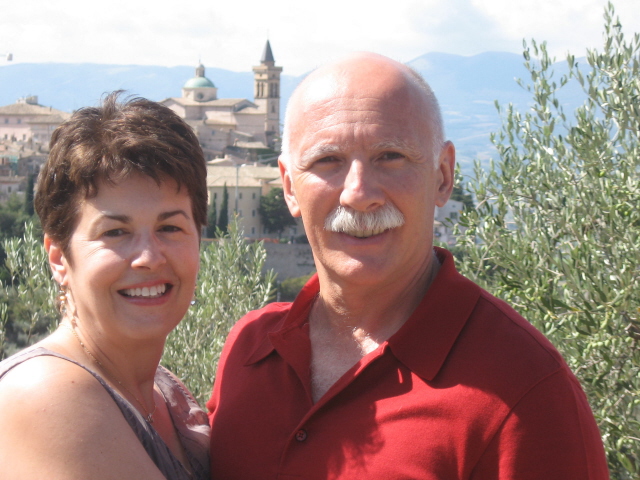 We flew into Rome’s Da Vinci Airport and spent the night at the Sofitel Hotel near Villa Borga. After dumping our bags off, we headed to the Spanish Steps to do a little “sightseeing” on Via Condotti. Ferragamo, Versace, Prada, etc., etc., etc… it felt a lot like shopping to me. The highlight of the evening was dinner at a great family run restaurant called “Santo Padre” (nickname for The Pope). We started with appetizers of grilled vegetables, tomato salad, tiny meatballs, soft goat cheese, prosciutto, and a liter of house red wine. They made great sweet potato compote with pureed onion, tomato, and red pepper. Very delicious! Our first course was meat ravioli in a sauce of fennel, parmigiano cheese and butter. For our second course, we had minced beef with olives; and then beef rollatini stuffed with carrot and celery. Both beef dishes were in a delicious, light beef consume. Dessert was a slice of cold, ripe watermelon. Quite a delicious dinner.
We flew into Rome’s Da Vinci Airport and spent the night at the Sofitel Hotel near Villa Borga. After dumping our bags off, we headed to the Spanish Steps to do a little “sightseeing” on Via Condotti. Ferragamo, Versace, Prada, etc., etc., etc… it felt a lot like shopping to me. The highlight of the evening was dinner at a great family run restaurant called “Santo Padre” (nickname for The Pope). We started with appetizers of grilled vegetables, tomato salad, tiny meatballs, soft goat cheese, prosciutto, and a liter of house red wine. They made great sweet potato compote with pureed onion, tomato, and red pepper. Very delicious! Our first course was meat ravioli in a sauce of fennel, parmigiano cheese and butter. For our second course, we had minced beef with olives; and then beef rollatini stuffed with carrot and celery. Both beef dishes were in a delicious, light beef consume. Dessert was a slice of cold, ripe watermelon. Quite a delicious dinner.
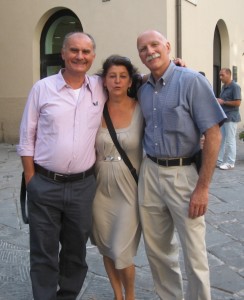 After church on Sunday we left Rome on the train to Foligno in the province of Umbria (pronounced “oombria”). Our great friends, Raffaella and Marcello Tori (Bluone Cooking Tours) met us at the train station and drove us to the agriturismo “Le Grazie” which is a gorgeous country house in the Bevagna hills. There we met our tour companions Theresa and Tyler, and Carol and Kevin. After a couple of glasses of crisp white wine from the area (soda bottle with no label; always good stuff!) with the husband and wife owners (Welfor and Maria), we headed to a great restaurant in the hills for dinner.
After church on Sunday we left Rome on the train to Foligno in the province of Umbria (pronounced “oombria”). Our great friends, Raffaella and Marcello Tori (Bluone Cooking Tours) met us at the train station and drove us to the agriturismo “Le Grazie” which is a gorgeous country house in the Bevagna hills. There we met our tour companions Theresa and Tyler, and Carol and Kevin. After a couple of glasses of crisp white wine from the area (soda bottle with no label; always good stuff!) with the husband and wife owners (Welfor and Maria), we headed to a great restaurant in the hills for dinner.
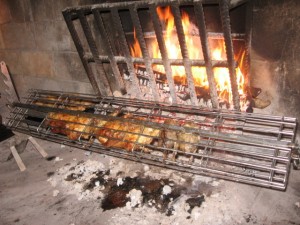 This hilltop restaurant in Bevagna is one of those places that you can only find if you’ve been there before. The region is known for their grilled foods and Sagrantino wine. We started with prosecco and platters of vegetable, fish, and egg bruschetta, local prosciutto that is different, yet just as delicious as prosciutto di Parma, grilled zucchini and tomato, stuffed eggplant, stuffed peppers, and delicious salted grilled bread. The main course was a mixed grill of sausage, lamb, and suckling pig and a couple of bottles of tasty red wine from the region called Rosso di Montefalco. The eggplant wasn’t the only thing that ended up stuffed that night.
This hilltop restaurant in Bevagna is one of those places that you can only find if you’ve been there before. The region is known for their grilled foods and Sagrantino wine. We started with prosecco and platters of vegetable, fish, and egg bruschetta, local prosciutto that is different, yet just as delicious as prosciutto di Parma, grilled zucchini and tomato, stuffed eggplant, stuffed peppers, and delicious salted grilled bread. The main course was a mixed grill of sausage, lamb, and suckling pig and a couple of bottles of tasty red wine from the region called Rosso di Montefalco. The eggplant wasn’t the only thing that ended up stuffed that night.
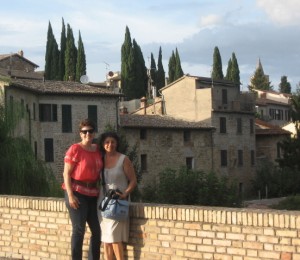 On Day 3 we headed to the ancient city of Trevi (no relationship to the fountain in Rome) for a little sightseeing and photos. This medieval hilltop city is slowly undergoing renovation and is a gem. Not far from downtown Trevi, we visited an olive oil cooperative and learned how extra virgin oil is made. Essentially, the olives are picked at the peak of ripeness and quickly brought to the cooperative where they are washed, ground, and the oil is separated from the solids via centrifugation (no pressing), followed by bottling, all in a closed system so no air can oxidize the oil. The solids that are collected are sold to another oil company which then presses the solids to get regular olive oil. Virgin olive oil (as opposed to extra virgin olive oil) goes through the same process as extra virgin olive oil, but is more acidic and/or insufficiently flavorful to be called extra virgin.
On Day 3 we headed to the ancient city of Trevi (no relationship to the fountain in Rome) for a little sightseeing and photos. This medieval hilltop city is slowly undergoing renovation and is a gem. Not far from downtown Trevi, we visited an olive oil cooperative and learned how extra virgin oil is made. Essentially, the olives are picked at the peak of ripeness and quickly brought to the cooperative where they are washed, ground, and the oil is separated from the solids via centrifugation (no pressing), followed by bottling, all in a closed system so no air can oxidize the oil. The solids that are collected are sold to another oil company which then presses the solids to get regular olive oil. Virgin olive oil (as opposed to extra virgin olive oil) goes through the same process as extra virgin olive oil, but is more acidic and/or insufficiently flavorful to be called extra virgin.
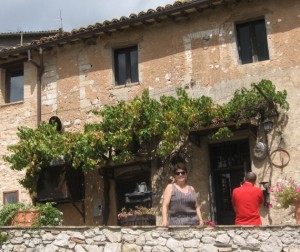 Marcello and Raffaella tried a new restaurant on us for lunch called Mangia e Bev (Eat and drink, catchy huh). We enjoyed another Rosso di Montefalco with a host of several appetizers (saving room for dinner) such as, chickpea salad, tomato and buffalo mozzarella, and radicchio and parmigiana cheese pizza followed by fresh fruits. Definitely worthy of a place on the tour.
Marcello and Raffaella tried a new restaurant on us for lunch called Mangia e Bev (Eat and drink, catchy huh). We enjoyed another Rosso di Montefalco with a host of several appetizers (saving room for dinner) such as, chickpea salad, tomato and buffalo mozzarella, and radicchio and parmigiana cheese pizza followed by fresh fruits. Definitely worthy of a place on the tour.
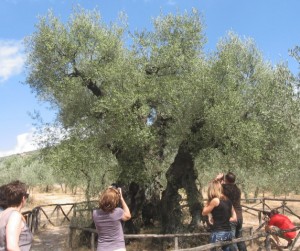 After a picturesque drive through Trevi, we stopped at an olive grove and found the oldest olive tree in the region which was planted in the year 304 AD. The gnarly tree trunk is actually split in four with branches growing out of all four trunks. The circumference of the tree is more than 9 meters. I’m sure your cell phone has an app that will do the conversion.
After a picturesque drive through Trevi, we stopped at an olive grove and found the oldest olive tree in the region which was planted in the year 304 AD. The gnarly tree trunk is actually split in four with branches growing out of all four trunks. The circumference of the tree is more than 9 meters. I’m sure your cell phone has an app that will do the conversion.
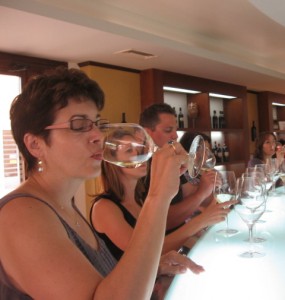 With another espresso under our expanding belts, we headed to the Arnaldo Caprai Winery for a tour, tasting, and cooking lesson. The winery grows many types of grapes over hundreds of acres and is responsible for the successful commercialization of the ancient but forgotten grape variety called sagrantino. This is a very difficult varietal to cultivate, and the vineyard was responsible for identifying and producing the best strains of sagrantino to improve their wine production. The winery makes a couple of white wines and many reds. We tried their red blend (Rosso) of 70% Sangiovese, 15% Cabernet, and 15% Sagrantino. They also make a 100% Sagrantino Reserve which is really tasty and a keeper.
With another espresso under our expanding belts, we headed to the Arnaldo Caprai Winery for a tour, tasting, and cooking lesson. The winery grows many types of grapes over hundreds of acres and is responsible for the successful commercialization of the ancient but forgotten grape variety called sagrantino. This is a very difficult varietal to cultivate, and the vineyard was responsible for identifying and producing the best strains of sagrantino to improve their wine production. The winery makes a couple of white wines and many reds. We tried their red blend (Rosso) of 70% Sangiovese, 15% Cabernet, and 15% Sagrantino. They also make a 100% Sagrantino Reserve which is really tasty and a keeper.
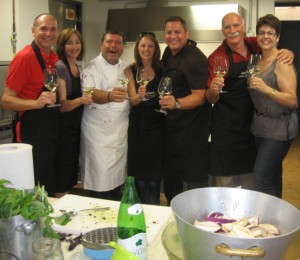 The cooking class at the winery was as entertaining as it was delicious. The chef, Salvatore Denaro is quite a character; a mix between Mario Bataglia and the Galloping Gourmet. We made tagliatelli in fresh tomato and basil, with fried eggplant; penne in sausage, ricotta, and tartufo sauce; and then sliced green tomato, goat cheese and soft pecerino cheese. From left to right, let me introduce you to our new friends: Kevin, Carol, Salvatore, Theresa, Tyler, and us. Much wine and much, much fun!
The cooking class at the winery was as entertaining as it was delicious. The chef, Salvatore Denaro is quite a character; a mix between Mario Bataglia and the Galloping Gourmet. We made tagliatelli in fresh tomato and basil, with fried eggplant; penne in sausage, ricotta, and tartufo sauce; and then sliced green tomato, goat cheese and soft pecerino cheese. From left to right, let me introduce you to our new friends: Kevin, Carol, Salvatore, Theresa, Tyler, and us. Much wine and much, much fun!
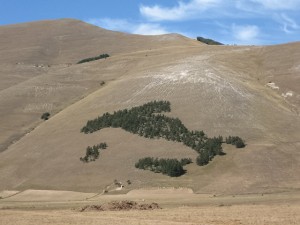 Day 4 started with a picturesque drive to the ancient city of Castellucio, which is in the high plains of Umbria boasting the best lentils and hang gliding in the world. In June, the plains are on fire with the many colors of blooming poppies and other flowers. Marcello got us a snack of roast pig, salami, wine, and red wine to tie us over till lunch (God forbid we should get hungry!). This is an image of Italy captured on a mountainside of Castellucio. Drunken shepherds with nothing to do I guess.
Day 4 started with a picturesque drive to the ancient city of Castellucio, which is in the high plains of Umbria boasting the best lentils and hang gliding in the world. In June, the plains are on fire with the many colors of blooming poppies and other flowers. Marcello got us a snack of roast pig, salami, wine, and red wine to tie us over till lunch (God forbid we should get hungry!). This is an image of Italy captured on a mountainside of Castellucio. Drunken shepherds with nothing to do I guess.
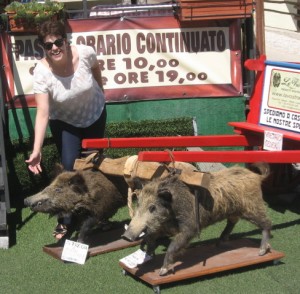 From Castellucio, we jumped in the van and headed to Norcia which is a 13th century town, famous for its expertise in preparing pork (“working the pork meat”). Lunch consisted of appetizers of many different pork salamis, truffle bruschetta, and the best grilled roast pork sausage we have ever eaten. In the picture, Mom prepares to work the pork meat. I know…you had to be there to get it.
From Castellucio, we jumped in the van and headed to Norcia which is a 13th century town, famous for its expertise in preparing pork (“working the pork meat”). Lunch consisted of appetizers of many different pork salamis, truffle bruschetta, and the best grilled roast pork sausage we have ever eaten. In the picture, Mom prepares to work the pork meat. I know…you had to be there to get it.
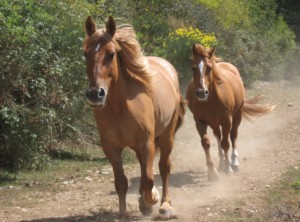 After a quick siesta, back at the agriturismo, we headed to Foligno which is preparing to celebrate its version of the famous Sienese horse race, “il Palo”. Each of the ten sections of the city has its own banner and selects a horse and bareback rider that is entered in the race. The race is several days away, but the town is getting ready by celebrating with great food and wine at its many taverns. Apart from its version of il Palo, Foligno is also the place where Saint Francis formally renounced all his wealth and started his evangelism.
After a quick siesta, back at the agriturismo, we headed to Foligno which is preparing to celebrate its version of the famous Sienese horse race, “il Palo”. Each of the ten sections of the city has its own banner and selects a horse and bareback rider that is entered in the race. The race is several days away, but the town is getting ready by celebrating with great food and wine at its many taverns. Apart from its version of il Palo, Foligno is also the place where Saint Francis formally renounced all his wealth and started his evangelism.
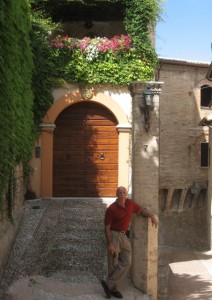 On Day 5 we headed to Perugia, famous for its Perugina chocolates. The town is another beautiful, historic city with many winding cobblestone streets through ancient buildings. We spent the morning window shopping and taking in the sights. We stopped at an outdoor café for lunch called Café Perugia. Mom had prosciutto, figs, melon, and prickly pairs and I had veal Milanese; we shared a half bottle of 2007 Tignorello. So what if its Tuscan!
On Day 5 we headed to Perugia, famous for its Perugina chocolates. The town is another beautiful, historic city with many winding cobblestone streets through ancient buildings. We spent the morning window shopping and taking in the sights. We stopped at an outdoor café for lunch called Café Perugia. Mom had prosciutto, figs, melon, and prickly pairs and I had veal Milanese; we shared a half bottle of 2007 Tignorello. So what if its Tuscan!
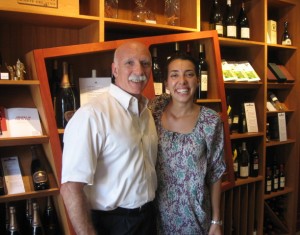 From there we headed into Deruta and the first winery of the area, Lungorotti. This winery makes many wines including a great white blend of trebbiano and grechetto grapes called Vigna il Pino and an incredible red blend of sangiovese and canaiolo grapes that rivals any of the Super Tuscans. Our host on the tour, the lovely Gracia, did a wonderful job of showing us around and pointing us to some great tasting wines. We ended up having 1 ½ cases shipped home. Yes she was VERY lovely.
From there we headed into Deruta and the first winery of the area, Lungorotti. This winery makes many wines including a great white blend of trebbiano and grechetto grapes called Vigna il Pino and an incredible red blend of sangiovese and canaiolo grapes that rivals any of the Super Tuscans. Our host on the tour, the lovely Gracia, did a wonderful job of showing us around and pointing us to some great tasting wines. We ended up having 1 ½ cases shipped home. Yes she was VERY lovely.
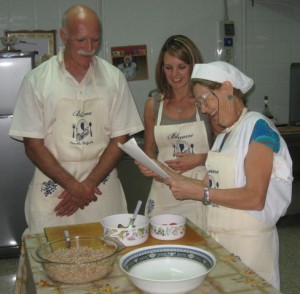 For dinner, we headed back to the agriturismo for a cooking lesson by Maria. It was incredible to watch and assist this 70+ pearl of a lady flit around the kitchen preparing some of the typical grain and bean meals of the region. We started with bruschetta with fava bean paste, followed by spelt salad (boiled whole grain, with tomato, and pickled peppers), chickpea soup, then lentil and sausage stew. For dessert we enjoyed faro strudel which was a strudel filled with ricotta cheese, chocolate, and boiled whole grain. The wines were local whites and reds. After dessert we enjoyed fresh dark and light figs with a glass of delicious, crisp passito which is a light distilled liquor of white wine.
For dinner, we headed back to the agriturismo for a cooking lesson by Maria. It was incredible to watch and assist this 70+ pearl of a lady flit around the kitchen preparing some of the typical grain and bean meals of the region. We started with bruschetta with fava bean paste, followed by spelt salad (boiled whole grain, with tomato, and pickled peppers), chickpea soup, then lentil and sausage stew. For dessert we enjoyed faro strudel which was a strudel filled with ricotta cheese, chocolate, and boiled whole grain. The wines were local whites and reds. After dessert we enjoyed fresh dark and light figs with a glass of delicious, crisp passito which is a light distilled liquor of white wine.
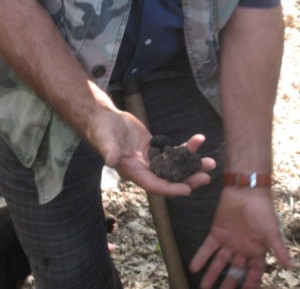 Day 6 started with a ride to a hilltop agriturismo in Spoleto for Mom’s favorite sporting event, Truffle Hunting. Yes the elusive truffle requires years of experience in hunting to master the ability of identifying and then successfully capturing a tasty tartufo nero. Or buy a great truffle hunting dog (they cost as much as $10,000) and let the dog bring the truffles to you for a snack.
Day 6 started with a ride to a hilltop agriturismo in Spoleto for Mom’s favorite sporting event, Truffle Hunting. Yes the elusive truffle requires years of experience in hunting to master the ability of identifying and then successfully capturing a tasty tartufo nero. Or buy a great truffle hunting dog (they cost as much as $10,000) and let the dog bring the truffles to you for a snack.
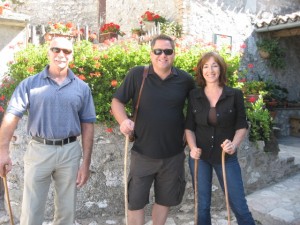 For lunch, the truffle hunter’s family fed us their homemade pork salumi (prosciutto and salami), pates, pasta with tomato and truffle, and then grilled sausage and pork ribs. OMG. Rosso di Montefalco which by now we have drinken (drunk, dranked, whatever…) OFTEN is delicious and I have to say is definitely the least expensive, most tasty wine for the dollar (or euro).
For lunch, the truffle hunter’s family fed us their homemade pork salumi (prosciutto and salami), pates, pasta with tomato and truffle, and then grilled sausage and pork ribs. OMG. Rosso di Montefalco which by now we have drinken (drunk, dranked, whatever…) OFTEN is delicious and I have to say is definitely the least expensive, most tasty wine for the dollar (or euro).
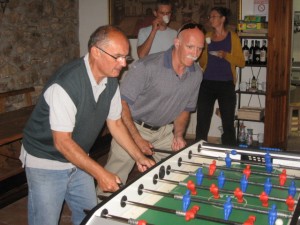 After a quick espresso and game of foosball, we loaded in the truck (van) and headed to Beverly (Spoleto center). There we walked through this beautiful ancient town and admired its architecture and forest. After all of that walking (maybe a kilometer) we needed a nap back at our rooms before dinner. Dinner was at a little restaurant in Bevagna where we started with one of Dad’s favorites, Proseco, as we munched on olives and bread. Mom ordered gnocchi in sagrentino wine followed by wild boar stew. Dad was still digesting his multiple helpings of pasta and ribs from lunch, so he only ordered the chefs version of bacala (salted codfish) which was one of grandpa’s best dishes. Oh yea, we drank a little wine too. Did I say that I am really beginning to like Rosso di Montefalco?
After a quick espresso and game of foosball, we loaded in the truck (van) and headed to Beverly (Spoleto center). There we walked through this beautiful ancient town and admired its architecture and forest. After all of that walking (maybe a kilometer) we needed a nap back at our rooms before dinner. Dinner was at a little restaurant in Bevagna where we started with one of Dad’s favorites, Proseco, as we munched on olives and bread. Mom ordered gnocchi in sagrentino wine followed by wild boar stew. Dad was still digesting his multiple helpings of pasta and ribs from lunch, so he only ordered the chefs version of bacala (salted codfish) which was one of grandpa’s best dishes. Oh yea, we drank a little wine too. Did I say that I am really beginning to like Rosso di Montefalco?
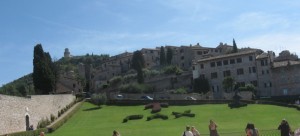 Day 7 and our last day of touring took us to Assisi which was made famous by the founder of the Franciscan order, St. Francis of Assisi who’s real name was John. The city is in great shape despite its many earthquakes (those monks are great fundraisers) and our guide, Brother James from Connecticut (no not that James), did an excellent job showing us the sites of the cathedral. There is far too much to say about St. Francis, so let it suffice to say that St. Francis saved the Catholic Church by getting it back on track (spreading the gospel and its message of service and humility) not by revolution or political statesmanship, but through leading by example in a time where the Church was more of a military and political party than a representative of our Lord, Jesus Christ. The Vatican might be more popular, but anyone who is a practicing Catholic should make a pilgrimage to Assisi in recognition of everything that is good about Catholicism. The food and wine are great too!
Day 7 and our last day of touring took us to Assisi which was made famous by the founder of the Franciscan order, St. Francis of Assisi who’s real name was John. The city is in great shape despite its many earthquakes (those monks are great fundraisers) and our guide, Brother James from Connecticut (no not that James), did an excellent job showing us the sites of the cathedral. There is far too much to say about St. Francis, so let it suffice to say that St. Francis saved the Catholic Church by getting it back on track (spreading the gospel and its message of service and humility) not by revolution or political statesmanship, but through leading by example in a time where the Church was more of a military and political party than a representative of our Lord, Jesus Christ. The Vatican might be more popular, but anyone who is a practicing Catholic should make a pilgrimage to Assisi in recognition of everything that is good about Catholicism. The food and wine are great too!
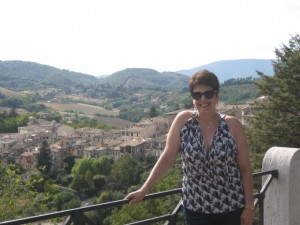 It was lunchtime after the tour so we headed to the Digioni Winery for lunch of salumi (you know what that is by now), bruschetta, roast pork, and their Grechetto (white wine), their Rosso di Montefalco, and their Sagrentino including their sagrentino passito. Have I said how delicious the Rosso di Montefalco is? The family combines 70% Sangiovese with 15% Sagrentino and 15% Merlot to make a tasty 14% alcohol Rosso. Our travel mate Kevin explained to us that ever since the creation of the wine point scale, wineries in the US and Italy have been targeting greater fruitiness in their wines because the person responsible for the rating system likes wines that are fruitier. What this has done is forced the wine growers to leave the grapes on the vine longer to increase the fruity flavor, which also increases the concentration of sugar resulting in higher alcohol content following fermentation (sugar = alcohol). This also explains what Mom and I have noticed about red wines which is that wines don’t keep as long as they used to anymore. Allowing the grapes to mature longer on the vine reduces the tannins and therefore reduces their antioxidant or “preservative” effect on the wine.
It was lunchtime after the tour so we headed to the Digioni Winery for lunch of salumi (you know what that is by now), bruschetta, roast pork, and their Grechetto (white wine), their Rosso di Montefalco, and their Sagrentino including their sagrentino passito. Have I said how delicious the Rosso di Montefalco is? The family combines 70% Sangiovese with 15% Sagrentino and 15% Merlot to make a tasty 14% alcohol Rosso. Our travel mate Kevin explained to us that ever since the creation of the wine point scale, wineries in the US and Italy have been targeting greater fruitiness in their wines because the person responsible for the rating system likes wines that are fruitier. What this has done is forced the wine growers to leave the grapes on the vine longer to increase the fruity flavor, which also increases the concentration of sugar resulting in higher alcohol content following fermentation (sugar = alcohol). This also explains what Mom and I have noticed about red wines which is that wines don’t keep as long as they used to anymore. Allowing the grapes to mature longer on the vine reduces the tannins and therefore reduces their antioxidant or “preservative” effect on the wine.
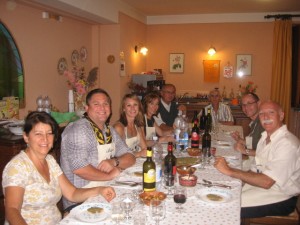 Well we all head off in our own directions tomorrow and we have to say it was great seeing our old friends, Raffaella and Marcello, and meeting our newest, best friends, Carol, Kevin, Theresa, Tyler and of course our host and hostess Welfor (seated at the head of the table) and Maria. Arrivaderci!
Well we all head off in our own directions tomorrow and we have to say it was great seeing our old friends, Raffaella and Marcello, and meeting our newest, best friends, Carol, Kevin, Theresa, Tyler and of course our host and hostess Welfor (seated at the head of the table) and Maria. Arrivaderci!